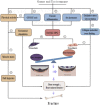Kidney tonifying traditional Chinese medicine: Potential implications for the prevention and treatment of osteoporosis
- PMID: 36699069
- PMCID: PMC9868177
- DOI: 10.3389/fphar.2022.1063899
Kidney tonifying traditional Chinese medicine: Potential implications for the prevention and treatment of osteoporosis
Abstract
The aging global population is increasingly affected by osteoporosis (OP), which is one of the most significant threats to the elderly. Moreover, its prevention and treatment situations have become increasingly severe. Therefore, it is imperative to develop alternatives or complementary drugs for preventing and treating osteoporosis. Kidney tonifying traditional Chinese medicine (KTTCM) has been used for the treatment of osteoporosis for a long time. Pharmacological studies have shown that kidney tonifying traditional Chinese medicine can promote osteoblasts, inhibit osteoclasts, and regulate the level of estrogen and plays vital roles in stimulating osteogenesis, restraining adipogenesis of marrow mesenchymal stem cells (MSCs), regulating the metabolism of calcium and phosphorus, and inhibiting oxidative stress. These effects are mediated by OPG/RANKL/RANK, BMP/Smads, MAPKs, and Wnt/β-catenin systems. To develop a safe, synergistic, effective, and homogenized TCM formula with robust scientific evidence to provide faster and more economical alternatives, the anti-osteoporosis ingredients and pharmacological mechanisms of kidney tonifying traditional Chinese medicine are recapitulated from the perspective of molecular and cell biology, and the safety and toxicity of kidney tonifying traditional Chinese medicine have also been reviewed in this paper.
Keywords: active ingredients; kidney tonifying traditional Chinese medicine; osteoporosis; pharmacological mechanism; safety and toxicity.
Copyright © 2023 Duan, Su, Ren, Zhou, Tang, Li and Li.
Conflict of interest statement
The authors declare that the research was conducted in the absence of any commercial or financial relationships that could be construed as a potential conflict of interest.
Figures
Similar articles
-
[Research progress on anti-osteoporotic active ingredients and pharmacological action mechanism of traditional Chinese kidney-tonifying and bone-strengthening drugs].Zhongguo Zhong Yao Za Zhi. 2015 Mar;40(6):1038-43. Zhongguo Zhong Yao Za Zhi. 2015. PMID: 26226741 Review. Chinese.
-
[Review for treatment effect and signaling pathway regulation of kidney-tonifying traditional Chinese medicine on osteoporosis].Zhongguo Zhong Yao Za Zhi. 2018 Jan;43(1):21-30. doi: 10.19540/j.cnki.cjcmm.20171106.002. Zhongguo Zhong Yao Za Zhi. 2018. PMID: 29552807 Review. Chinese.
-
Brain neural effects of the 'tonifying kidney and benefiting marrow' method in the treatment of osteoporosis.J Tradit Chin Med. 2019 Dec;39(6):902-909. J Tradit Chin Med. 2019. PMID: 32186162
-
Mechanisms by which kidney-tonifying Chinese herbs inhibit osteoclastogenesis: Emphasis on immune cells.Front Pharmacol. 2023 Feb 6;14:1077796. doi: 10.3389/fphar.2023.1077796. eCollection 2023. Front Pharmacol. 2023. PMID: 36814488 Free PMC article. Review.
-
Cornus officinalis: a potential herb for treatment of osteoporosis.Front Med (Lausanne). 2023 Dec 4;10:1289144. doi: 10.3389/fmed.2023.1289144. eCollection 2023. Front Med (Lausanne). 2023. PMID: 38111697 Free PMC article. Review.
Cited by
-
Nourishing Yin traditional Chinese medicine: potential role in the prevention and treatment of type 2 diabetes.Am J Transl Res. 2024 Jan 15;16(1):234-254. doi: 10.62347/CVNI4988. eCollection 2024. Am J Transl Res. 2024. PMID: 38322552 Free PMC article. Review.
-
Recent advances in the multifaceted mechanisms of catalpol in treating osteoporosis.Front Pharmacol. 2025 Mar 4;16:1560715. doi: 10.3389/fphar.2025.1560715. eCollection 2025. Front Pharmacol. 2025. PMID: 40103589 Free PMC article. Review.
-
Effects of traditional Chinese medicine Zuo-Gui-Wan on gut microbiota in an osteoporotic mouse model.J Orthop Surg Res. 2025 Feb 1;20(1):128. doi: 10.1186/s13018-025-05504-w. J Orthop Surg Res. 2025. PMID: 39891262 Free PMC article.
-
The association between lipid accumulation product and osteoporosis in American adults: analysis from NHANES dataset.Front Med (Lausanne). 2025 Mar 19;12:1513375. doi: 10.3389/fmed.2025.1513375. eCollection 2025. Front Med (Lausanne). 2025. PMID: 40177287 Free PMC article.
-
Evaluation of the Therapeutic Potential of the Methanolic Extract and Fractions of Datura stramonium in Paracetamol-intoxicated Rabbits.Curr Pharm Des. 2025;31(21):1720-1732. doi: 10.2174/0113816128365599241226113546. Curr Pharm Des. 2025. PMID: 39835560
References
-
- Bai B. H., Xie X. W., Li D. P., Xu S. H., Huang J. (2019). Research progress of eucommia ulmoides and its active ingredients in prevention and treatment of osteoporosis. J. Liaoning Univ. Tradit. Chin. Med. 21, 126–129. 10.13194/j.issn.1673-842x.2019.01.034 - DOI
-
- Bertoldo F., Cianferotti L., Di Monaco M., Falchetti A., Fassio A., Gatti D., et al. (2022). Definition, assessment, and management of vitamin D inadequacy: Suggestions, recommendations, and warnings from the Italian society for osteoporosis, mineral metabolism and bone diseases (SIOMMMS). Nutrients 14, 4148. 10.3390/nu14194148 - DOI - PMC - PubMed
Publication types
LinkOut - more resources
Full Text Sources
Miscellaneous




